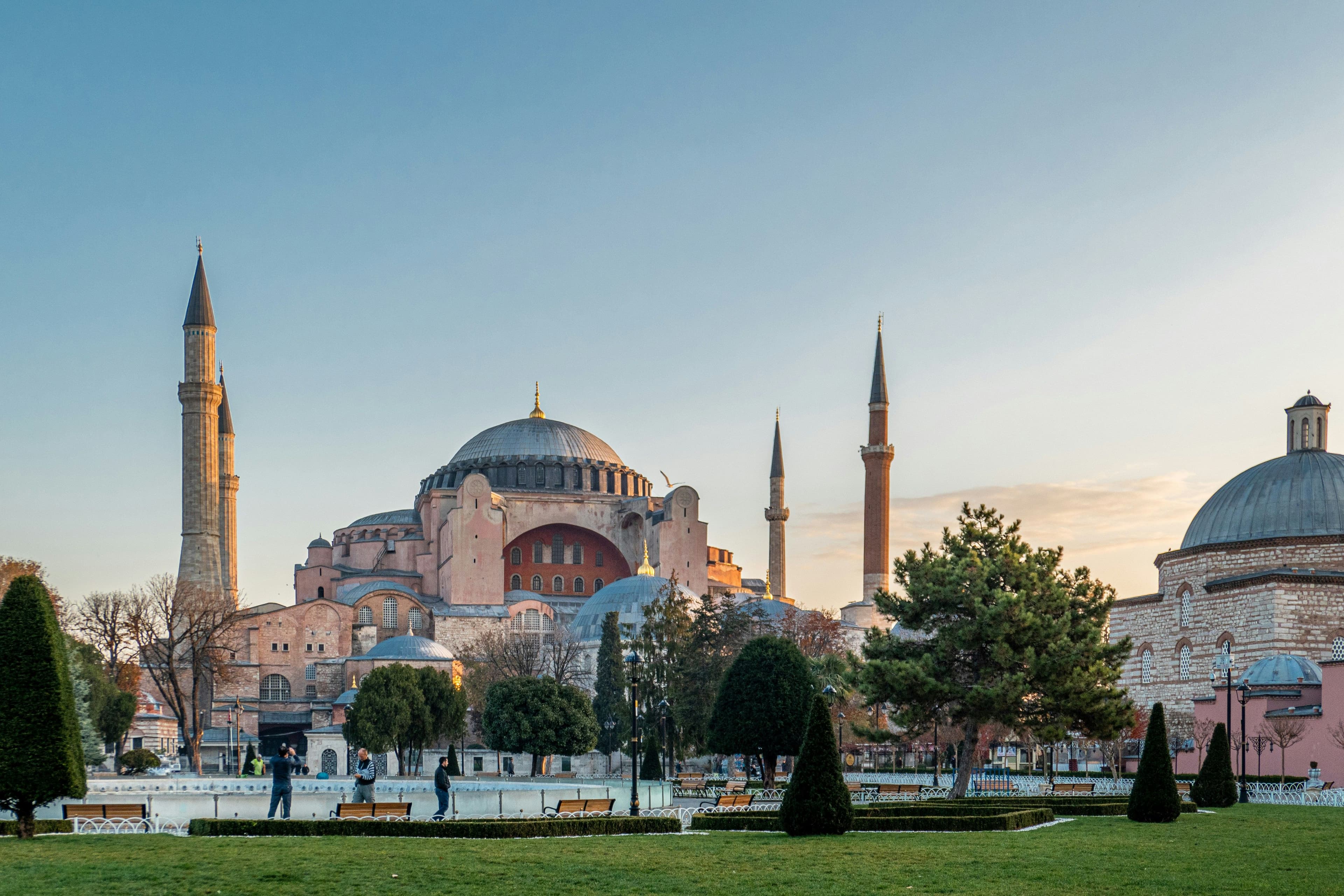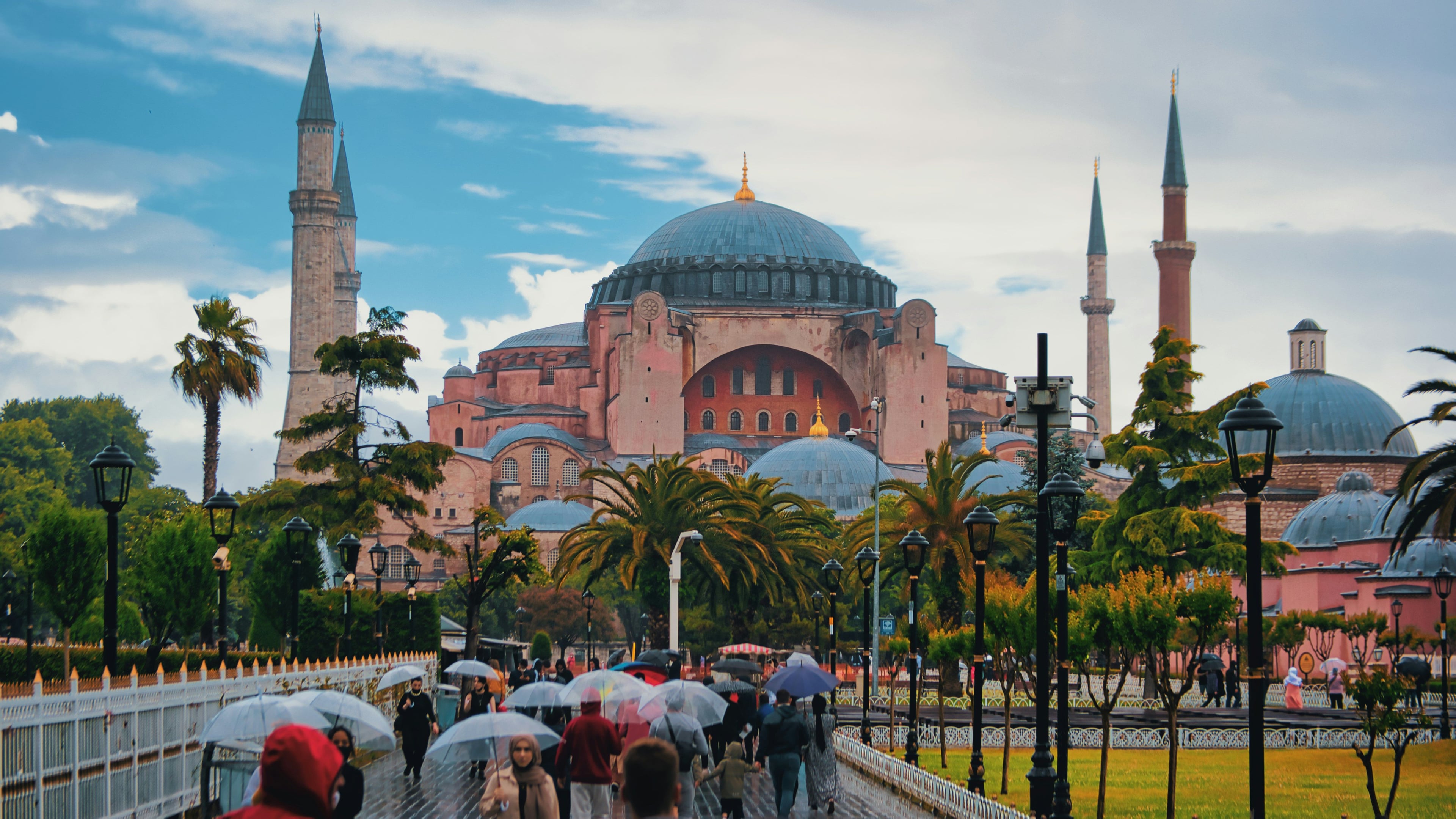When people think of Istanbul, Hagia Sophia is often the first image that appears in their minds. It stands gracefully in the heart of the old city, representing centuries of art, culture, and faith. Its magnificent dome, golden mosaics, and intricate calligraphy tell the story of two great empires.
For travelers, visiting Hagia Sophia is more than just a sightseeing experience. It is a journey through history and architecture. This guide shares everything you need to know before your visit, including its background, how to get there, the best time to visit, nearby attractions, and the best local restaurants and cafes.
History of Hagia Sophia
The history of Hagia Sophia begins in the year 360 when Emperor Constantius II built the first church on this site. It was destroyed during riots and rebuilt twice before Emperor Justinian I ordered the grand structure we see today. Construction was completed in 537, and it quickly became the largest church in the Byzantine Empire.
For nearly a thousand years, Hagia Sophia was the center of Christianity and the most important cathedral in the world. When Sultan Mehmed II conquered Constantinople in 1453, he converted it into a mosque. The Ottomans added minarets, chandeliers, and beautiful Arabic calligraphy, blending two great artistic traditions.
In 1935, under the Turkish Republic, Hagia Sophia became a museum open to people of all cultures and beliefs. In 2020, it was once again designated as a mosque. Today, visitors of all faiths can enter and admire its rich history and remarkable architecture.
The building’s massive dome seems to float in the air, supported by hidden pillars. Inside, you can see mosaics of the Virgin Mary and Christ, alongside Islamic inscriptions that honor Allah and the Prophet Muhammad (PBUH). This harmony of Christian and Islamic art makes Hagia Sophia one of the most unique landmarks in the world.

Best Time to Visit Hagia Sophia
The best time to visit Hagia Sophia is in spring, from April to May, or in autumn, from September to October. The weather during these months is pleasant, and you can explore comfortably without large crowds.
If you enjoy quiet travel experiences, early winter between November and December is also a good choice. You can enjoy the peaceful atmosphere and cool air while exploring the old city.
For the best experience, plan your visit early in the morning when the mosque opens. The crowds are lighter, and you will have more time to take in the details of the interior. It is also better to visit on weekdays instead of weekends. Avoid Friday afternoons because the mosque is used for prayer and some sections may be closed to visitors.
Photography is allowed, but be respectful during prayer times. Move quietly, dress modestly, and take time to appreciate the calm and beauty of this historic place.
Highlights and Features of Hagia Sophia
- Massive Dome: The central dome, measuring 31 meters across, appears to float on light, creating an awe-inspiring sight that has influenced architects for centuries.
- Byzantine Mosaics: Stunning gold mosaics depicting Christ, the Virgin Mary, and saints decorate the upper galleries and ceilings, revealing Byzantine artistry at its peak.
- Ottoman Calligraphy: Enormous circular medallions bearing the names of Allah, the Prophet Muhammad, and early caliphs blend perfectly with the Christian elements, showing cultural harmony.
- Marble Columns and Floors: The marbles used inside were sourced from across the ancient world, including Egypt and Greece, symbolizing the empire’s vast reach.
- Weeping Column: A popular spot for visitors who believe the marble pillar has healing powers. Many place their thumb inside a hole and make a wish.
- Minarets and Exterior Beauty: The tall minarets surrounding the main dome were added during the Ottoman era, giving Hagia Sophia its famous skyline presence.
- The Mihrab and Minbar: Facing Mecca, the mihrab and minbar showcase intricate Ottoman craftsmanship and serve as key elements in the mosque’s layout.
- Incredible Acoustics: The vast dome and marble surfaces create a unique echo effect, enhancing the spiritual atmosphere during prayers or quiet reflection.
How to Get There
Hagia Sophia is located in the Sultanahmet area of Istanbul, which is the heart of the city’s historical district. The transportation system in Istanbul makes reaching it easy for everyone.
- By Tram: The most convenient way is to take the T1 tram line and get off at the Sultanahmet station. From there, Hagia Sophia is only a short five-minute walk away.
- By Metro: You can take the M2 metro line to Vezneciler station. From there, transfer to the tram or take a short taxi ride to Sultanahmet.
- By Bus: Several public buses run to Sultanahmet Square. You can take routes toward Eminönü or Beyazıt, then walk a few minutes to reach the site.
- By Taxi: If you are staying farther away, taxis are available throughout the city. However, keep in mind that traffic around the old city can be slow, especially in the afternoon.
- On Foot: If you are staying nearby, walking is the best option. The streets of Sultanahmet are full of charm, with small shops, bakeries, and old buildings that make the walk enjoyable.
Photography Spots and Views
For travelers who love capturing memories, Hagia Sophia offers countless photo opportunities.
- Inside the Mosque: Stand beneath the dome and point your camera upward to capture its golden light and detailed mosaics. Try photographing through the arches for dramatic frames.
- Outside: The best exterior view is from Sultanahmet Square, where you can capture both Hagia Sophia and the Blue Mosque in one shot. Another excellent spot is from the gardens behind Hagia Sophia, especially at sunset when the golden dome glows beautifully.
- From Rooftops: If you want a panoramic photo, head to the terrace of Seven Hills Restaurant nearby. The combination of Hagia Sophia, the Bosphorus, and city rooftops makes for a stunning picture.
Guided Tours of Hagia Sophia
Exploring Hagia Sophia with a guided tour adds depth and meaning to your visit. A knowledgeable local guide helps you uncover the fascinating stories behind its architecture, mosaics, and transformation over the centuries. You’ll understand how this monument became a symbol of both Byzantine and Ottoman history.
Entry to Hagia Sophia is free, but guided tours are highly recommended for those who want to learn more about its cultural and historical importance. Most tours are small-group experiences led by professional guides who explain the structure’s artistic details, restoration work, and spiritual significance.
Here are some of the best guided tours of Hagia Sophia that visitors love:
- Istanbul Old City Walking Tour – A full-day journey through Hagia Sophia, Blue Mosque, and Topkapi Palace with an expert guide.
- Private Hagia Sophia Tour with Local Historian – Perfect for travelers who prefer a personalized and detailed experience.
- Hagia Sophia Evening Tour – Offers a peaceful visit when the crowds have thinned and the mosque is beautifully lit.
- Half-Day Sultanahmet Heritage Tour – Combines Hagia Sophia, the Hippodrome, and the Basilica Cistern in one cultural route.
- Cultural Highlights of Istanbul Tour – An excellent option for first-time visitors who want to explore the heart of the city.
Booking Tip:
Book your guided tour in advance, especially during spring and autumn when visitor numbers are high. Most tours begin near Sultanahmet Square and last around two to three hours. Dress modestly and carry a scarf if you plan to enter the prayer areas.
Nearby Attractions
Hagia Sophia is surrounded by some of Istanbul’s most famous landmarks, all within walking distance.
- Blue Mosque: Located directly across from Hagia Sophia, the Blue Mosque is known for its stunning blue tiles and elegant domes. It is one of the most photographed places in Istanbul and a must-see for anyone exploring the area.
- Topkapi Palace: A short walk from Hagia Sophia, Topkapi Palace was once the home of Ottoman sultans. Visitors can see royal chambers, treasures, and courtyards with breathtaking views of the Bosphorus.
- Basilica Cistern: Just a few steps away, the Basilica Cistern is an underground wonder built in the sixth century. It once stored water for the Byzantine city and today offers a mysterious and peaceful experience under its beautifully lit columns.
- Grand Bazaar: About fifteen minutes away on foot, the Grand Bazaar is one of the oldest and largest covered markets in the world. You can shop for carpets, ceramics, jewelry, spices, and souvenirs while enjoying the lively atmosphere.
- Hippodrome of Constantinople: Right next to the Blue Mosque, the ancient Hippodrome was once the site of chariot races and public events. Today, you can see monuments such as the Serpent Column and the Egyptian Obelisk.
Restaurants and Cafes Nearby
After visiting Hagia Sophia, you will find many restaurants and cafes nearby that serve delicious Turkish food.
- Tarihi Sultanahmet Köftecisi: This legendary restaurant is famous for its traditional Turkish meatballs known as köfte. It has been serving travelers and locals for over a century.
- Matbah Restaurant: Located near Hagia Sophia, Matbah offers Ottoman-inspired dishes once served in the royal palace. Try specialties like lamb stew with apricots or spiced rice pilaf for a true taste of history.
- Seven Hills Restaurant: This rooftop restaurant is popular for its amazing view of Hagia Sophia and the Bosphorus. It is the perfect place for dinner or a cup of Turkish coffee at sunset.
- Kybele Café and Restaurant: A charming café filled with colorful lanterns and warm décor. It is ideal for relaxing after sightseeing and enjoying Turkish tea or baklava.
What to Try Nearby
- Turkish meatballs or köfte
- Lahmacun, a thin Turkish-style pizza
- İmam bayıldı, eggplant stuffed with vegetables
- Baklava or künefe for dessert
- Traditional Turkish tea or coffee
The area around Hagia Sophia is full of dining options. Most restaurants are tourist-friendly, but if you walk a little farther from the main square, you will find smaller places with authentic flavors and friendly prices.
Travel Tips for Visiting Hagia Sophia
- Dress modestly since it is an active mosque. Women may be asked to cover their heads.
- Remove your shoes before entering prayer areas.
- Visit early in the morning to avoid long lines.
- Carry a small bottle of water, especially in summer.
- Avoid visiting during prayer times for easier access to all sections.
- Keep some local currency for small purchases or donations.
- Take your time to look at the mosaics, marble floors, and massive dome.
- Explore the surrounding streets on foot to experience more of Istanbul’s charm.
Final Thoughts
Hagia Sophia is more than just a building. It is a symbol of Istanbul’s history and a meeting point of cultures. Its beauty lies not only in its architecture but also in the stories it carries from the Byzantine and Ottoman eras.
A visit to Hagia Sophia is a journey through time. You will feel the spiritual atmosphere and the artistic harmony of two civilizations inside its walls. After exploring, step out into Sultanahmet Square, enjoy the view of the Blue Mosque, and end your day with a meal or coffee while watching the sunset over this timeless landmark.
